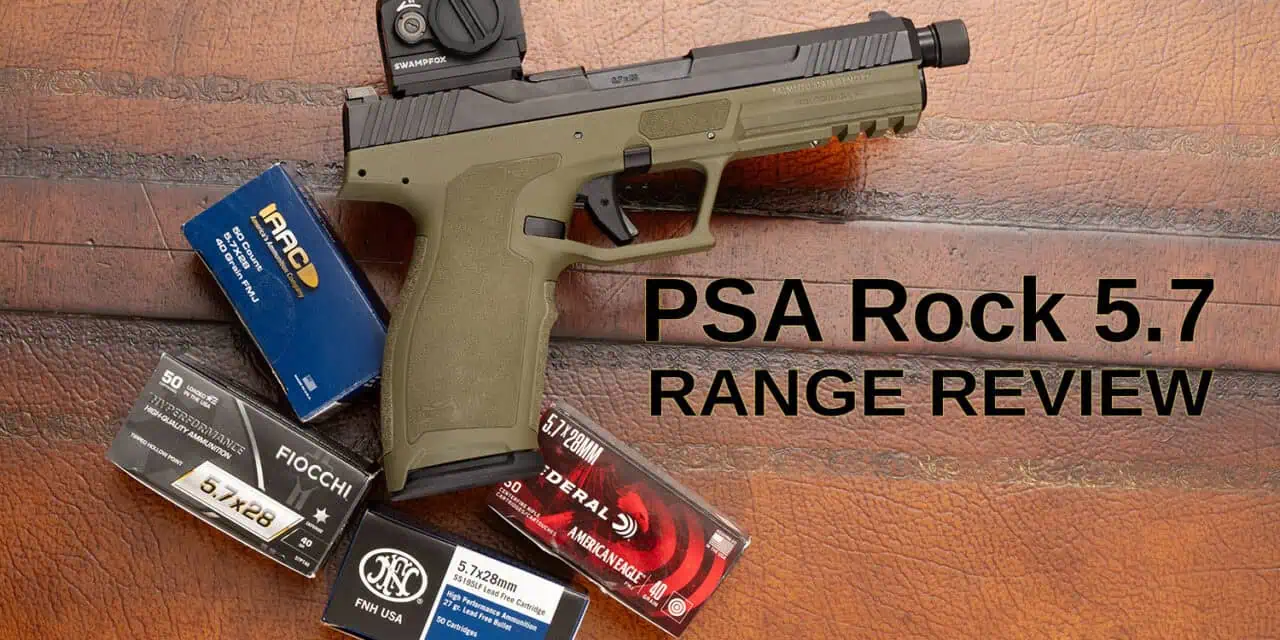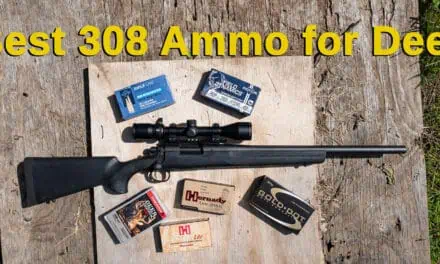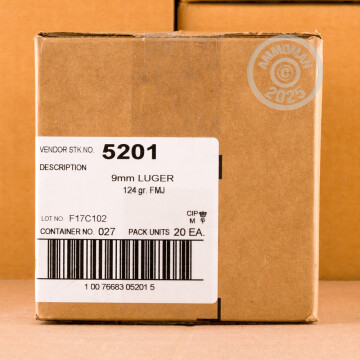Palmetto State Armory may have successfully followed the path of Ford Motor Company.
First, they came out with several budget firearms of good decent quality. We’ll call these their equivalents of Models T and A. Then, they followed up with higher-performing products still at reasonable prices — much like the late 1930s Ford V8s.
PSA’s 5.7×28 Rock is one such product — a lightweight high-capacity handgun with excellent performance and ergonomics.
What We Like About the 5.7 Rock
PSA’s Rock 5.7 delivers a lot of things to like. First, you get a ton of capacity with the 23-round magazine. The feel of the pistol in the hand is great in terms of ergonomics. Its minimal felt recoil should allow you to get a ton of shots off on target about as effectively as possible.
What Could Improve
The 8-pound trigger is our only real criticism of Palmetto’s Rock 5.7 pistol. It was difficult to fire multiple shots rapidly on target as we’ll describe in detail in this review.
How the Rock Improves Upon Past 5.7’s

The concept of a small-caliber high-velocity pistol is as old as self loading pistols themselves: Borchardt C93 and Mauser C96 qualified back in the 1890s. Then, TT33 and CZ52 in the 1930s-50s. Followed by FN 57 in the late 1990s.
However, the ergonomics of those guns were questionable for my taste. This made the PSA Rock’s fit refreshing. It seemed to match my hand perfectly.
Capacity
Capacity quest also goes back quite some time, with a mid-1930s select-fire C96 variant and the 1998 FN 57 each holding 20 rounds in detachable box magazines. The Rock one-ups them all with flush-fitting 23-rounders. 5.7x28mm ammo being 2mm smaller in diameter than 9×19 Luger rounds, this capacity proved possible without making the double-stack magazine too thick, while the double-feed configuration permitted easy loading by hand. Going with striker firing also permitted a grip that’s slimmer front to back, with no space allocated to a mainspring. Magazine release isn’t ambidextrous but is reversible. The pistol’s slide stop lever is on the left side only.
Recoil and Rapid Fire
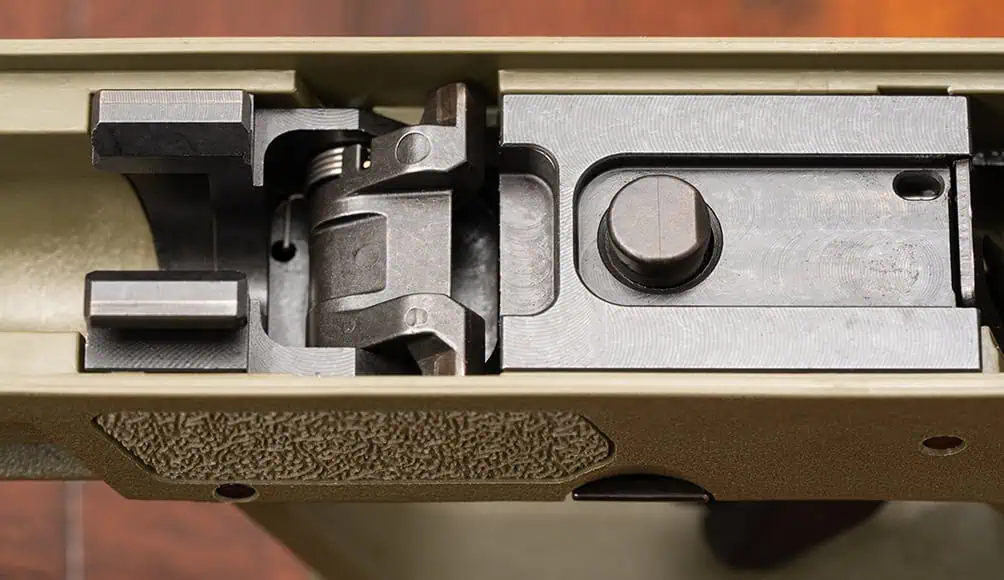
When I shot the original 57 many years ago, I recall disliking the feel of the polymer grip flexing on recoil. Felt recoil is almost entirely absent on the Rock: while it exists as a physical force, it is barely perceived by the shooter holding onto a superbly well designed grip. The polymer frame has just enough texture to promote retention, but not enough to abrade or even mark the palm. Stainless Cerakoted slide is rust and glare resistant, while the metal-reinforced frame is snag-resistant and comfortable to the hand. Prominent beavertail and low boreline add up to excellent control even on rapid fire. Shooting the pistol one-handed, strong side or weak, is easy.
The Rocks’ 5.2-inch barrel is heavy for this caliber. It’s fluted to promote cooling, so the pistol can sustain a high volume of fire, especially in the RK1 variant with ventilated slide. Lever-delayed blowback action is quite clever. First, the barrel and the slide recoil together about quarter of an inch, then the barrel is arrested while the slide has to work against spring-loaded levers with a mechanical disadvantage. This slows down primary extraction until the chamber pressure drops to safe levels. The slide and the spent case then accelerate out of battery for another third of an inch before starting to re-compress the striker spring which augments the main recoil spring in slowing down the slide. This combination gives easy extraction, positive ejection, and light recoil. In my experience, the pistol has been unfailingly reliable. Spent cases come out undamaged and ready for reloading if desired.
Rock 5.7 Sights
The sights are standard Glock pattern, so the white dot setup can be easily upgraded if desired. I went with a Swampfox Kraken red dot — it was the only optic on hand to fit one of the two provided adapter plates (RMR and Docter). Because of the extra adapter plate required, the optic sit about 3mm higher than I would have liked, though it had no effect on practical accuracy. Mounting a smaller optic with the Docter plate would have allowed co-witnessing with irons. All Rock pistols come optics ready.
Weight
At 25 oz unloaded, this pistol feels quite light for the size. Thanks to the high 50kpsi chamber pressure, the 5.2-inch barrel is sufficient for fairly high muzzle velocity: around 1650fps for 40gr loads, near 2100fps for 27-30gr loads. If that sounds paltry compared to 22 WMR, remember that the rated velocity for the rimfire cartridges are from rifle barrels, while pistols of that caliber produce between 1250fps with most ammunition and 1400fps with dedicated short-barrel loads. While expanding and fragmenting bullets are available, the most prominent terminal effect in this caliber comes from rapid tumbling of the long, thin FMJ or tipped HP projectiles.
The bullets of 5.7×28 ammo fired from handguns aren’t moving fast enough to produce hydrostatic shock, but they do reliably defeat most soft body armor and inflict a moderate amount of damage. While stopping with one shot isn’t even close to guaranteed, low recoil and none-existent muzzle flip make for easy multiple hits.
Accuracy Testing
In my tests, firing pairs as fast as I could pull the trigger, I got about an inch separation between impacts at ten yards. With the cartridge being relatively new and not widespread until recently, the number of case studies is limited. Of course, there is one event involving 5.7×28 that stands out — the 2009 Fort Hood shooting.
One person armed with a 5.7 pistol and a mix of frangible practice ammunition and ballistic tip hollow points killed thirteen military-age adults, wounded 32 more in ten minutes before being shot and stopped by a base police officer. The high body count confirmed earlier NATO trials that declared 5.7x28mm noticeably superior to 9x19mm.
Why Not To Go With 5.7×28
The main downside to the caliber is the increased muzzle blast and report due to high operating pressure, somewhat mitigated by the smaller bore diameter. While the bullets are supersonic, the report moderates quite well with modestly sized steel suppressors. Almost all Rock models come with 1/2×28 threaded muzzles, the exceptions being state-compliant offerings. Standard height or tall suppressor-friendly sights are available.
23-round steel magazines drop free. They lock in easily even when full, and the baseplates are shaped to avoid pinching the hand during loading. PSA offers various packages, with one, three, or even ten magazines. Magazine cost for the Rock is another advantage with the standard 23-rounders coming in at about $20 retail. For comparison’s sake, 20-round Ruger 57 mags ran about $30 each at the time of publication.
While Rock magazines weigh almost as much as Glock 17 or Beretta 92 mags, they hold a few more rounds of ammunition. The cartridges themselves weigh just about half of what 9mm Luger ammo weighs, making the 5.7 pistol easier to provision in the field. With many makers offering 5.7 firearms recently, ammunition availability has improved to the point of this caliber being nearly mainstream.
Trajectory
Flat trajectory lends 5.7 to longer-range shooting. While its terminal effect falls off with velocity, even a marginally effective hit at a distance is still a hit. This is where the trigger limits the practical accuracy to about 60 yards. It is possible to stay on a silhouette at 100, but that takes time and effort.
Thoughts on the Trigger
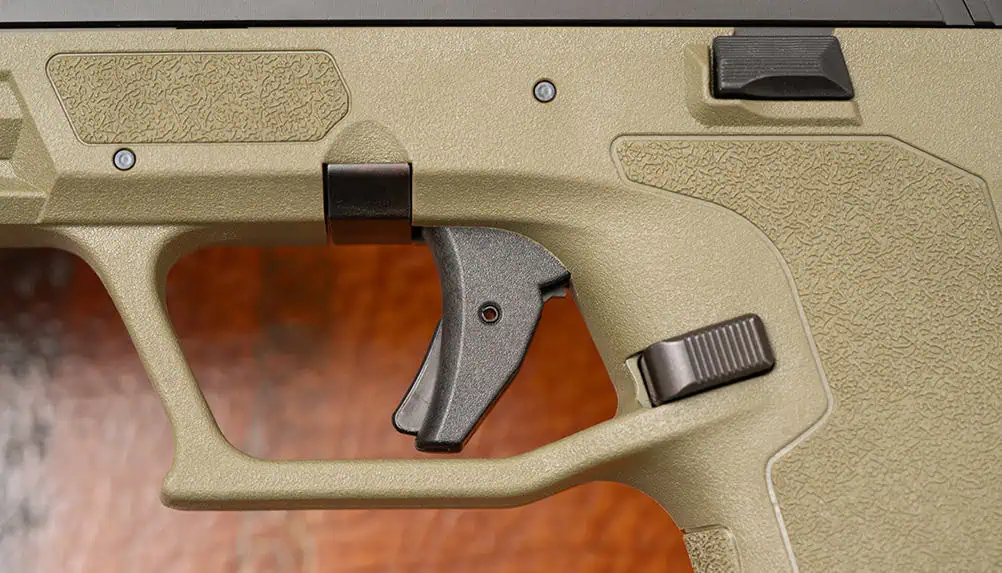
The trigger with an integrated hinged safety tab feels much like the one on the Soviet TT33: a long, light take-up followed by a very short, heavy second-stage. The trigger breaks at 8 pounds, and the re-set is very short at about 1/8 inch. This works perfectly for a combat pistol, facilitating fast repeat shots with acceptable accuracy: even at 25 yards, rapid-fire spread is limited to about three inches. The trigger being the limiting factor, I found little difference in groups between different ammunition types.
Disassembly of the Rock 5.7
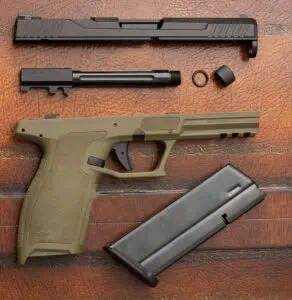 Take-down is simple: decock the gun, pull the slide back a quarter inch, pull down the take-down tab forward of the trigger, push the slide forward until it overhangs the dust cover by a third of an inch, lift up the slide and barrel assembly. Reassembly is pushing the slide down and back until the latch clicks. PSA recommends cleaning every 500 rounds, there’s no reason to neglect the recommendation with the take-down being this simple.
Take-down is simple: decock the gun, pull the slide back a quarter inch, pull down the take-down tab forward of the trigger, push the slide forward until it overhangs the dust cover by a third of an inch, lift up the slide and barrel assembly. Reassembly is pushing the slide down and back until the latch clicks. PSA recommends cleaning every 500 rounds, there’s no reason to neglect the recommendation with the take-down being this simple.
Other 5.7 Pistol Options to Consider
Ruger 5.7, S&W, and FN.
In the late 2010’s, your options for a 5.7×28 were pretty limited. You could go with the FN — either their P90 carbine or the 5.7 pistol. Limited firearm availability meant there was real reason for ammo makers to produce a ton of rounds. Ammo prices stayed high and options were scarce.
Just before 2020, Ruger launched their 57 pistol to a lot of fanfare. It didn’t take long for Smith & Wesson to follow with their own 5.7 design.
PSA’s Rock 5.7 came next with its launch in 2022. It’s a more than viable option in this space and for the price, it definitely deserves your attention.

